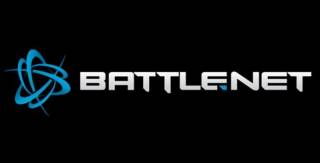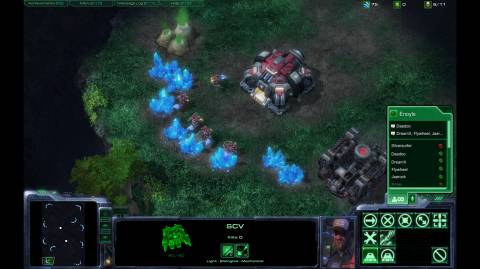Overview

Battle.net is an online platform developed by Blizzard Entertainment that enables its users to chat, create and join game lobbies, and manage their downloaded games. The second version of Battle.net was released in July 2010, alongside the release of Starcraft 2.
Battle.net currently only supports Blizzard Entertainment games. Some of the first games that were made avaliable for the platform, notably Starcraft and Warcraft III, are still being played today. Starcraft is the most popular Battle.net game to date.
In 2016, Blizzard announced that they were retiring the Battle.net name for their online service. This changed happened in March of 2017, where the Battle.net client changed its name to Blizzard.
Battle.net 2.0
Battle.net 2.0 was announced during the Leipzig Gaming Convention in 2008, and was released publicly in July 2010, alongside the release of Starcraft 2.
The features added or improved included:
 In game friends list in Starcraft II.
In game friends list in Starcraft II. Concept Battle.net achievements in Starcraft II.
Concept Battle.net achievements in Starcraft II.The features promised but not yet implemented are:
- Clan Support
- eSports Support
- Chat Channels
- Map Marketplace
 Battle.net achievements in Starcraft II upon release.
Battle.net achievements in Starcraft II upon release.Battle.net 2.0 has an increased emphasis on community interaction, compared to its predecessor.
In recent years, Battle.net evolved to form its own client, similar to Steam, where you can buy and download all Blizzard games associated with your account.
Facebook integration
Within Battle.net 2.0, users can add friends from their Facebook profile to their Battle.net friends list, if they use the same email for their Facebook and Battle.net accounts.
Battle.net 2.0 Supporting Older Games
The question of whether or not Battle.net 2.0 supporting older games was brought up during an interview with Greg Canessa, the head of the Battle.net team, during Blizzcon 2009. His reply was: "it could be potentially, and there is a big list of stuff we need to do. Obviously our number one goal is to get Starcraft 2 to a level of the Battle.Net experience to a world class level of service and support for Starcraft 2. That is the number one goal...
Maybe you could do something with the social stuff. You know, it is on the list. We just don't know exactly where it is on the list."
Plans to Monetize Battle.net 2.0
During Blizzcon 2008's Diablo III gameplay panel, Jay Wilson was asked the question of whether or not Battle.net 2.0 would stay free, like its predecessor. His response was: "We are looking to monetize Battle.Net so that we get to keep making these games and updating features, we kind of have to," as reported by Joystiq.
At the same panel, Bobby Kotick, Activision's CEO and president of Activision Blizzard, was asked what Blizzard's plans were for assets such as Starcraft II and Battle.net, and replied with this: "...On the Blizzard side, [we need to] really be figuring out things like the StarCraft business model for the future, with in-game advertising and sponsorship, [which have] really not been something that has moved the dial for anybody in the videogame industry, but that we think presents tremendous opportunity for the future," according to Next-Gen. Following this, Blizzard clarified that, as expected, only the Battle.net component of StarCraft II will contain advertising.
Real ID
From a Blizzard press release: "Battle.net's Real ID system is a new, optional layer of identity beyond the standard in-game character level of identity that keeps players connected to each other across multiple Blizzard Entertainment games. When players mutually agree to become Real ID friends, they'll have access to a wealth of additional features designed to enhance their social gaming experience."
Real ID is an additional way for users to identify their friends within Blizzard's games. Their friends' real names appear on their friends list, instead of their screenname, in both World of Warcraft or Starcraft II. Furthermore, users can see minor details about their Real ID friends, for example what server and character their friends are playing on in World of Warcraft, or what game type they're competing in in Starcraft II.
Real ID's use on Blizzard's forums controversy
Blizzard once announced that Real ID would be used in an upcoming update of the Battle.net forums (displaying the user's full name in their posts instead of their screenname), but was hit with such backlash against the idea that they recanted and decided not to implement it after all.
Their initial reasoning, stated by community manager Nethaera, was that “removing the veil of anonymity typical to online dialogue will contribute to a more positive forum environment, promote constructive conversations, and connect the Blizzard community in ways they haven’t been connected before.”
Bashiok, the Diablo 3 community manager, bore a large amount of the backlash. Disgruntled Blizzard forum users, eager to demonstrate to Blizzard what a lack of anonymity would do, posted every bit of personal information they could about Bashiok. They were able to find and abuse his Facebook page, and posted his real address, where he lived with his mother.
Battle.net 1.0
 The original Battle.net interface for Starcraft
The original Battle.net interface for StarcraftThe Battle.net interface in many of its supported games starts users off in a general chat room. Users are able to make their own chat rooms, public or private, which will let them talk with certain people. Also, users can send private chat messages to specific users.
Users can usually search for game lobbies, or create their own game lobby. There is a password system which lets users set a password for a game lobby, in order to make it private. Some games allow users to chat with each other in a game lobby, before its host initiates play.
During gameplay, users are able to send messages via text to other players in the match. They can choose who gets to see their messages, their teammates or the whole enemy team. This is a key feature, because it lets players strategize in secrecy.
There was no voice chat in the original Battle.net service. Battle.net 2.0 added this feature to certain games.
Notable Games
In 1997, Battle.net officially launched for use in Diablo (which was released in 1996). In this early stage, Battle.net was mostly just a P2P matchmaking system and had many issues, including a lack of saving features and, due to the lack of a server system in the game, it allowed players to cheat. This lead to Blizzard taking action by adding anti-cheat software and CD keys to their future games.
In 1998, Starcraft was released and used the Battle.net service. To prevent the servers turning into the disaster that was Diablo, Blizzard added a CD key check, which has been required for all Blizzard PC games since. Now only people who had entered their unique 13-digit CD Key were allowed to play on Battle.net.
Starcraft was a huge success, and (with its expansion pack Brood War) is one of the most successful online games to date. This game gained a huge cult following from RTS players, particularly gamers from South Korea, where the game is actually its national sport. Millions of players are still playing today, and its community has been going strong for the past 10 years.
A remake of Warcraft II: Tides of Darkness (originally released in 1995), dubbed the ' Battle.net Edition' was released in 1999 with Battle.net support.
 Diablo II's Battle.net interface
Diablo II's Battle.net interfaceDiablo II was released in 2000 with Battle.net built right in it. It was the first Battle.net game to run entirely off of Blizzard's servers. In a similar fashion to Valves Steam Cloud, players were finally able to store their characters on the servers, keeping all of their stats saved online.
This gave Blizzard much more control of their game, particularly the multiplayer aspects. Since they were all running off the same servers, Blizzard was able to ban cheaters and people who had pirated the game.
In 2002, Warcraft III: Reign of Chaos was released, and Blizzard added tons of new features to Battle.net, like the Anonymous Matchmaking service, which matches players with other players based on their skill level.
 Warcraft III's Battle.net interface
Warcraft III's Battle.net interfaceOther new features included tournaments, win counts, friend lists and clan support.
The expansion pack, The Frozen Throne, was released in 2003.
In 2009, Blizzard merged all World of Warcraft account with Battle.net accounts.
Starcraft II launched alongside the latest iteration of the service, Battle.net 2.0, and makes use of the new features, such as cross game text and voice chat, and advanced matchmaking.
Notable Events
World of Warcraft merge
In 2009 Blizzard merged World of Warcraft with Battle.net. All users were required to tie their World of Warcraft accounts to their Battle.net account.
Major Account Deletions
In November 2008, Blizzard deleted over 300,000 Battle.net accounts due to them being suspected of using cheating software.
List of games which use Battle.net
Battle.net 1.0
Battle.net 2.0
Log in to comment